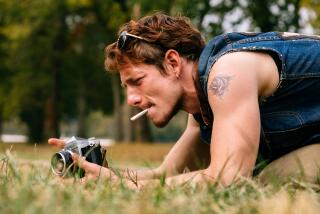Bikers face their fears on a Himalayan ride in ‘The Highest Pass’
Even experienced motorcyclists might hesitate to ride 1,200 miles over flooded and rutted roads, risking altitude sickness and avalanches to travel up the world’s highest motorable mountain pass. But the bikers who trekked the Indian Himalayas to 18,300 feet in the new documentary “The Highest Pass” were on a mission — not only to have an adventure but also to confront their fears and overcome self-created limitations.
Part travelogue, part spiritual quest, “The Highest Pass” is a filmic fusion of the outer and inner journeys riders experience, taken to physical and mental extremes.
The 21-day trip wasn’t conceived as a film or even a group ride. Indian yogi Anand Mehrotra simply had been wanting to motorcycle through the Himalayas by himself and had found a one-month window to do so in spring 2010.
But when one of his American students, a filmmaker named Adam Schomer, asked if he could visit India to study with him, Mehrotra’s only available time was the month he planned to ride. He invited his student along, though Schomer had never ridden a motorcycle. The party snowballed into eight and, eventually, a movie. “The Highest Pass,” directed by Slamdance Film Festival co-founder Jon Fitzgerald, opens Friday at Laemmle theaters in Santa Monica and Pasadena.
Mehrotra, who was 27 during filming, is an unlikely tour guide. He had never ridden the upper reaches of the Himalayas. And, despite truck-involved crashes by two riders in the first two days of the trip, he pushed his followers to continue.
“For me it’s not about the skill,” said Mehrotra, whose handlebars are decorated with prayer beads. “It’s about the heart. Skill, one can master in time because it’s just a mental phenomena. The intention was to inspire people from inside.”
Mehrotra is from the same city where the film begins: Rishikesh, the birthplace of yoga. Trained by yogis from a young age, he began teaching at 16 — a couple of years after he began riding motorcycles. He now travels the world teaching Sattva, or “radical aliveness,” a type of yoga that encourages practitioners to let go of their egos, go beyond their minds and grow their hearts so they can exist without fear.
“Fear,” Mehrotra says in the film, “makes us dumb.”
Few things inspire fear like riding a motorcycle on one-lane mountain roads without guardrails, or at night without streetlights.
“I faced a lot of things that first night ride,” said Schomer, who had ridden a moped for only two weeks before upgrading to the single-cylinder Royal Enfield motorcycle he and the other riders wheeled up the mountain. “I didn’t know if people were behind me or in front of me. ... The light on the Enfield was not that strong and the light coming toward you blinds you completely. [You think], I might die in the next two seconds and then you come through. Do that a few times, and something shifts in you. I’m still here. What else you got?” said Schomer who, like other riders on the trip questioned Mehrotra’s methodology, and at times dismissed him as reckless, heartless and overly intellectual.
Reacting to fear, “the mind looks for something to blame,” said Mehrotra, who often led his motorcyclists in Buddhist prayer by the roadside as they headed toward the mountains of Ladakh, or Little Tibet, to visit a monastery and an oracle.
“The bike is the quickest way to just be one with existence,” he said. “It’s very meditative.”
susan.carpenter@latimes
More to Read
The biggest entertainment stories
Get our big stories about Hollywood, film, television, music, arts, culture and more right in your inbox as soon as they publish.
You may occasionally receive promotional content from the Los Angeles Times.






